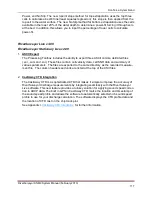
SonTek, a Xylem brand
RiverSurveyor S5/M9 System Manual (February 2013)
117
Power, and No Slip. The new 3-point slope method for top extrapolation uses the top three
cells to calculate a best-fit line (least squares regression); this slope is then applied from the
top cell to the water surface. The new No Slip method for bottom extrapolation uses the cells
available in the lower 20% of the water depth to determine a power-fit forcing it through zero
at the bed. In addition, this allows you to input the percentage of lower cells to calculate
power-fit.
RiverSurveyor Live v3.00
RiverSurveyor Stationary Live v2.00
1.
ASCII Export
The Processing Toolbox includes the ability to export three ASCII comma delimited files
(.vel, .sum and .snr). These files contain cell velocity data, cell SNR data and summary of
various parameters. The files are exported to the same directory as the recorded measure-
ment file. The column headers and units are listed at the top of the CSV files.
2.
CastAway CTD Integration
The CastAway CTD is a sophisticated CTD that makes it simple to improve the accuracy of
RiverSurveyor discharge measurements by integrating seamlessly with the RiverSurveyor
Live software. This new feature provides a turnkey solution for applying sound speed correc-
tion to ADCP data. The built in GPS in CastAway CTD marks the location and timestamp of
the sound speed profile and allows the software to automatically select which sound speed
profile to use for your discharge calculation. The software displays the CTD profile data and
the location of CTD cast on the ship track plot.
See Appendix I.
















































